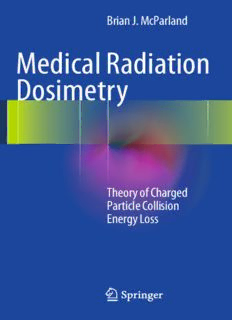
Medical Radiation Dosimetry: Theory of Charged Particle Collision Energy Loss PDF
Preview Medical Radiation Dosimetry: Theory of Charged Particle Collision Energy Loss
Brian J. McParland Medical Radiation Dosimetry Theory of Charged Particle Collision Energy Loss Medical Radiation Dosimetry Brian J. McParland Medical Radiation Dosimetry Theory of Charged Particle Collision Energy Loss BrianJ.McParlandBASc,MSc, PhD,CPhys,CSci,FCCPM,FIPEM,FInstP Amersham,Buckinghamshire,UK ISBN978-1-4471-5402-0 ISBN978-1-4471-5403-7(eBook) DOI10.1007/978-1-4471-5403-7 SpringerLondonHeidelbergNewYorkDordrecht LibraryofCongressControlNumber:2013951430 ©Springer-VerlagLondon2014 Thisworkissubjecttocopyright.AllrightsarereservedbythePublisher,whetherthewholeorpart of the material is concerned, specifically the rights of translation, reprinting, reuse of illustrations, recitation,broadcasting,reproductiononmicrofilmsorinanyotherphysicalway,andtransmissionor informationstorageandretrieval,electronicadaptation,computersoftware,orbysimilarordissimilar methodologynowknownorhereafterdeveloped.Exemptedfromthislegalreservationarebriefexcerpts inconnectionwithreviewsorscholarlyanalysisormaterialsuppliedspecificallyforthepurposeofbeing enteredandexecutedonacomputersystem,forexclusiveusebythepurchaserofthework.Duplication ofthispublicationorpartsthereofispermittedonlyundertheprovisionsoftheCopyrightLawofthe Publisher’s location, in its current version, and permission for use must always be obtained from Springer.PermissionsforusemaybeobtainedthroughRightsLinkattheCopyrightClearanceCenter. ViolationsareliabletoprosecutionundertherespectiveCopyrightLaw. The use of general descriptive names, registered names, trademarks, service marks, etc. in this publicationdoesnotimply,evenintheabsenceofaspecificstatement,thatsuchnamesareexempt fromtherelevantprotectivelawsandregulationsandthereforefreeforgeneraluse. While the advice and information in this book are believed to be true and accurate at the date of publication,neithertheauthorsnortheeditorsnorthepublishercanacceptanylegalresponsibilityfor anyerrorsoromissionsthatmaybemade.Thepublishermakesnowarranty,expressorimplied,with respecttothematerialcontainedherein. Printedonacid-freepaper SpringerispartofSpringerScience+BusinessMedia(www.springer.com) For Sharon, ‘Who ever loved that not loved at first sight?’ As You Like It Act III, Scene 5 Preface Background Medicalradiationdosimetryisthedisciplineofevaluating,throughmeasurementor calculation,theabsorbeddosereceivedbyapatientasaconsequenceoftherapeutic or diagnostic exposures to ionising radiation. A high level of accuracy in the calculation and measurement of this dosimetry is essential for the optimisation of patient treatment and diagnostic efficacy, the assurance of patient safety and the continueduseofmedicalexposuresinretrospectiveepidemiologicalstudiesofthe effects of ionising radiation. The achievement of this accuracy requires detailed theoretical knowledge of the means through which the radiation interacts with matter.Astheabsorbeddoseistheimmediateconsequenceofthetransferofkinetic energy by an energetic charged particle to a medium as it decelerates through collisionswithatoms,thetheoreticalunderstandingofthisphysicalmechanismof collisionalenergylossisfundamentaltoallmedicaldosimetryevaluationsandisthe subjectofthisbook. The use ofionising radiationsinmedical practice is extensive.Throughout the world approximately 2.5 billion people are exposed annually for the detection or diagnosisofdiseaseorabnormalpathology(IAEA2002).Thatis,overoneinthree of all humans receive medical ionising radiation each year for diagnoses with theresultofanassociatedannualworldwidepercaputeffectivedose1reportedby theInternationalAtomicEnergyAgency(IAEA)tobeabout0.4mSv,2,3Inaddition 1Theeffectivedoseisameasureofradiocarcinogenicandhereditarydamageriskresultingfrom non-uniformexposuresatlowradiationabsorbeddoses(ICRP1991)andhastheunitofsievert (Sv).Atypicalannualeffectivedoseresultingfromtheexposuretonaturalsourcesofradiationis about2.5mSv. 2This is estimated to be about 78 % due to non-dental x-ray procedures, 21 % due to dental radiologicalexaminationsand1%duetonuclearmedicineexaminations. 3Thereisawidevariationinthiseffectivedosedependinguponthedegreeandcomplexityof medical care (UNSCEAR 2000) with countries with the highest levels of health care being associated with a per caput annual effective dose of 1.3 mSv whereas those with the lowest beingassociatedwith0.02mSv. vii viii Preface to these diagnostic exposures, about 5.5 million patients worldwide each year undergo therapeutic irradiations which involve absorbed doses of the order of 50 Gray or more, magnitudes at which the concept of the effective dose becomes invalid. The features and consequences of these two medical applications of ionising radiation differ beyond just the magnitudes of the associated absorbed doses. The biological risks associated with the low absorbed radiation doses of diagnosticimagingarecancerandhereditarydamageandaretermedstochasticas the probability of incidence is a function of absorbed dose whereas the ultimate severity or consequence of the effect, should it occur, is not. These risks are the consequence of radiation-induced mutations or oncogene activations. Hence, theneedforaccuratedosimetryisnecessaryfortheestimatingoftheseprobabilistic risks.Ontheotherhand,theprobabilisticregimefadesawayatthegreaterabsorbed doses of radiotherapy. These absorbed doses lead to cell death and resulting macroscopic acute damage. These effects are deterministic due to their being a result of the radiation-caused depletion of cells in an organ or tissue. Below an absorbed dose threshold, no pathology is evident as the irradiated organ or tissue can tolerate the loss ofa finitenumber of cells andstill retain function.However, beyond this absorbed dose threshold, functional impairment becomes evident clinically and the degree of damage increases with the radiation absorbed dose. Deterministic effects are sought in radiation oncology as the number of sterilised tumourcellsandtheconsequenttumourcontrolprobability4 increasewithabsorbed dose.5 The balance of medical benefit (in terms of efficacious diagnosis, cure or effective palliation) against the risk (characterised by late-term radiation-induced cancers, ineffective tumour sterilisation or normal tissue damage) requires that theradiationabsorbeddosetothepatientbeknowneffectivelysoastoenablethe physician,whoisresponsibleultimatelyforpatientcare,tomakeareasonedmedical andscientificjudgement. Exclusion of Radiative Collisions Medical ionising radiations are either charged (electrons, positrons, protons or heavy ions) or uncharged (photons or neutrons), with the latter creating secondary charged particles through interactions with atoms in the tissue. In both cases, the outcomeofthemedicalirradiationwillbeafluxofenergeticchargedparticleswithin tissueandwhichlosetheirkineticenergythroughinteractionswiththeatomswithin thatmedium.Therearetwogeneralcategoriesofenergyloss,ofwhichonlyoneisthe focusofthisbook. 4CompletedescriptionsofsuchradiobiologicaleffectscanbefoundinHallandGiaccia(2006). 5Acutedeterministiceffectshavebeenreportedinsomediagnosticimagingprocedures,suchas fluoroscopy,althoughsuchoccurrencesareinfrequentandcanbeascribedtoimproperpractice (Wagneretal.1999). Preface ix 100 Carbon 10 ) 2 m c V g Total e M ( dEρdx Collision 1 Radiative 0.1 0.01 0.1 1 10 100 1,000 Electron kinetic energy (MeV) Fig.P.1 Themasstotal,collisionandradiativestoppingpowersforelectronsincarbon,usedas anelementalsurrogateforsofttissue.The‘total’curveisthesumofthe‘radiative’and‘collision’ energylossrates.Thedifferenceinmagnitudesbetweenthecollisionandradiativemasscollision stopping powers for electron energies typical of medical applications (below 20 MeV) demonstrateswhybremsstrahlungisnotconsideredhereformedicaldosimetryevaluations Thefirstis thatofthe energyloss ofamovingchargedparticle asthe resultof collisions with atomic electrons. Energy transfer to the medium through these collisions leads to local energy deposition and to nonlocal energy deposition. Thenonlocalenergydepositionisduetosecondaryrecoilelectronswithsufficient kinetic energy to travel from the original interaction site and deposit their kinetic energiesatadistance. The second is the radiative energy loss of bremsstrahlung by which x-ray photons are created through the electromagnetic interaction between the charged particle and the nuclear Coulomb field. Any absorbed dose that ultimately results from this interaction will be the consequence of a subsequent interaction of the photonwithanatomandtheejectionofanatomicelectronwhichdeceleratesand transfersenergytothemedium. Of these two categories, the theory of collisional energy losses in medical dosimetry is the core topic of this book whereas radiative energy loss theory is not.Thejustificationforexcludingradiativelossesinatextbookdevotedtomedical radiation dosimetry is that the bremsstrahlung production cross section is signifi- cantonlyforlow-masschargedparticles(electronsorpositrons)withhighkinetic energiesinteractingwithmediawithhighatomicnumbers.Theseconditionsarenot metforelectronsorpositronsintissueatenergiestypicalofmedicalapplications. To demonstrate this quantitatively, Fig. P.1 shows the mass stopping power
Description: